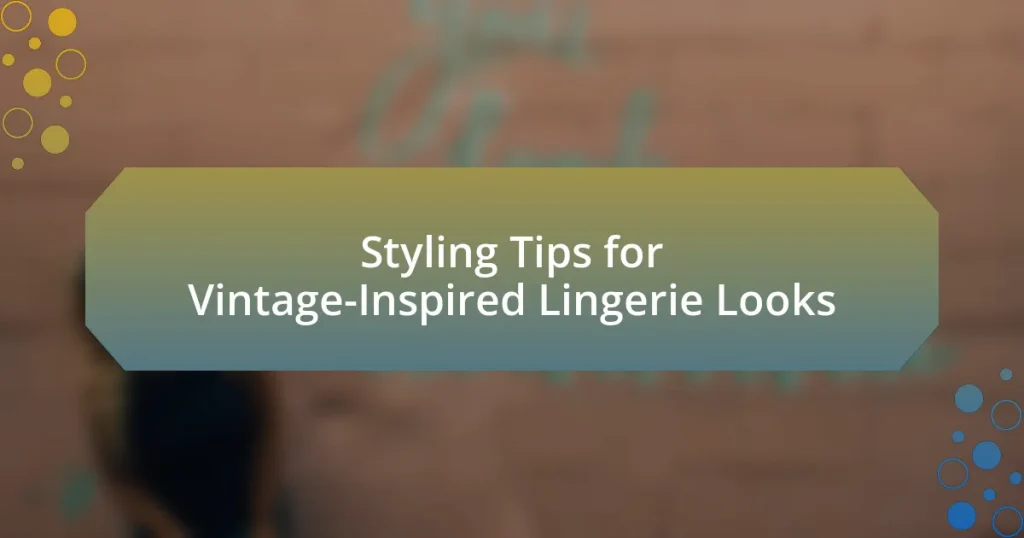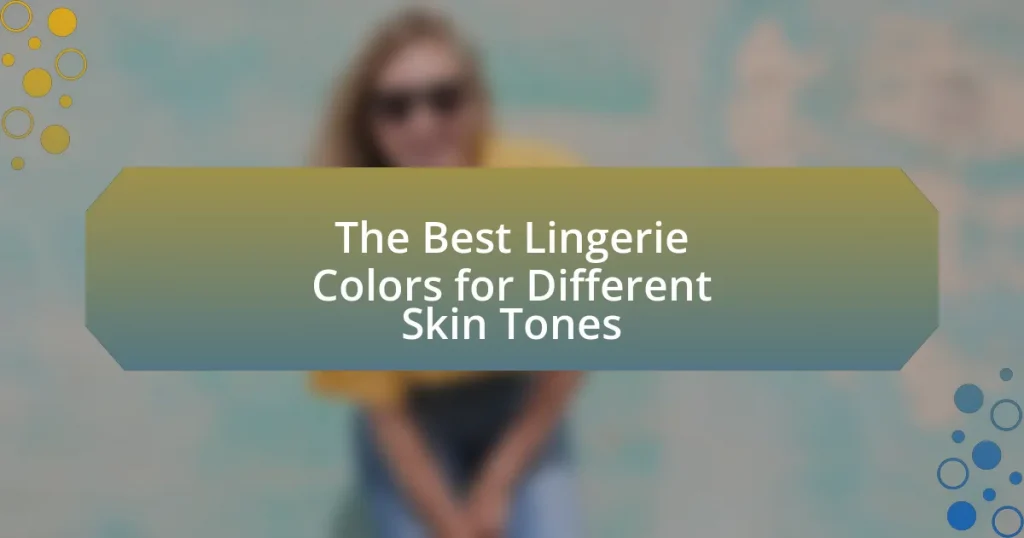The article examines the significant impact of social media on lingerie trends, highlighting how platforms like Instagram and TikTok shape consumer preferences and enhance brand visibility. It discusses the transformative role of influencers in the lingerie market, emphasizing their ability to drive purchasing decisions and foster brand loyalty through authentic content. Additionally, the article explores how social media trends influence lingerie designs, promote body positivity, and reflect broader cultural shifts, while also detailing effective strategies for lingerie brands to engage with their audience and leverage analytics for trend prediction. Overall, it provides a comprehensive overview of the relationship between social media and the lingerie industry, from influencer collaborations to the evolution of runway shows.
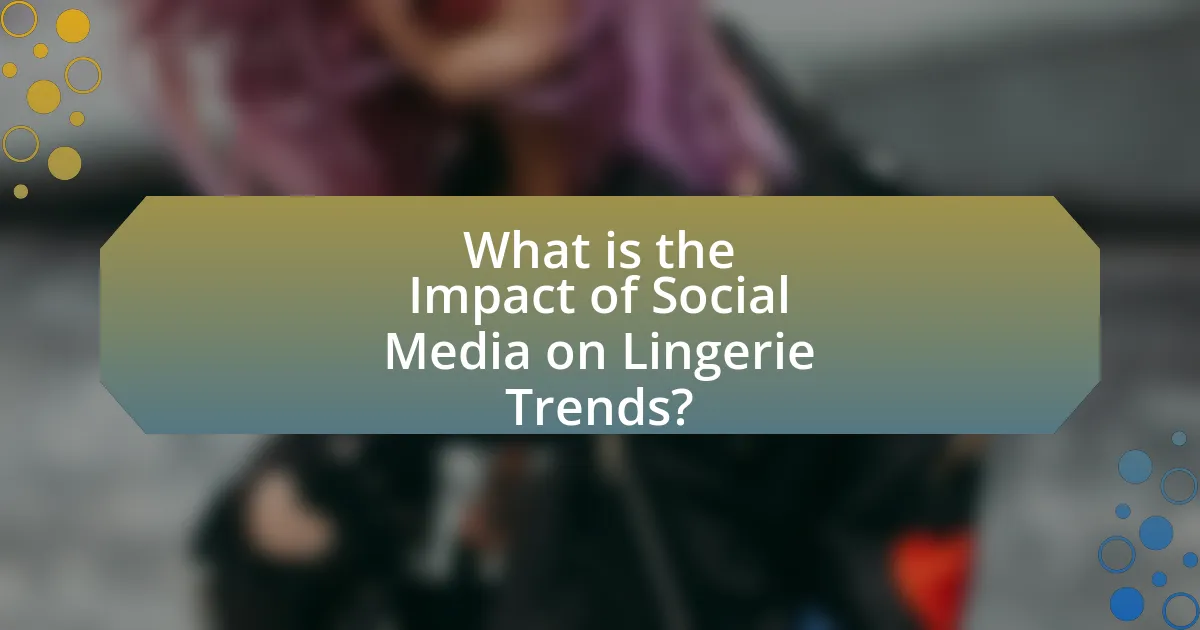
What is the Impact of Social Media on Lingerie Trends?
Social media significantly influences lingerie trends by shaping consumer preferences and driving brand visibility. Platforms like Instagram and TikTok allow influencers to showcase lingerie styles, creating immediate trends that resonate with their followers. For instance, a study by the NPD Group found that social media exposure can increase lingerie sales by up to 30%, as consumers are more likely to purchase items they see endorsed by popular figures. Additionally, brands leverage user-generated content to enhance authenticity, leading to a more engaged audience and a shift towards body positivity and inclusivity in lingerie marketing.
How has social media transformed the lingerie industry?
Social media has transformed the lingerie industry by enabling brands to engage directly with consumers and leverage influencer marketing. This shift has allowed lingerie companies to showcase their products in diverse and relatable contexts, moving away from traditional advertising methods. For instance, platforms like Instagram and TikTok have become essential for brands to reach younger audiences, with 70% of consumers stating they are influenced by social media when making purchasing decisions. Additionally, user-generated content has fostered a sense of community and authenticity, as real customers share their experiences and styles, further driving sales and brand loyalty.
What role do social media platforms play in shaping consumer preferences?
Social media platforms significantly influence consumer preferences by providing a space for brands to engage directly with consumers and showcase products through visual content. Platforms like Instagram and TikTok allow lingerie brands to leverage influencer marketing, where popular figures promote products to their followers, creating aspirational lifestyles that consumers seek to emulate. Research indicates that 49% of consumers rely on influencer recommendations when making purchasing decisions, highlighting the effectiveness of social media in shaping preferences. Additionally, user-generated content and reviews on these platforms enhance trust and authenticity, further guiding consumer choices in the lingerie market.
How do social media trends influence lingerie designs and styles?
Social media trends significantly influence lingerie designs and styles by shaping consumer preferences and driving brand visibility. Platforms like Instagram and TikTok allow influencers to showcase various lingerie styles, leading to increased demand for specific designs, such as bralettes and high-waisted panties, which have gained popularity through viral content. Additionally, brands often analyze trending hashtags and user-generated content to identify emerging styles, ensuring their collections align with current consumer interests. For instance, a study by the Fashion Institute of Technology found that 70% of consumers are influenced by social media when making fashion purchases, highlighting the direct impact of these platforms on lingerie trends.
Why are influencers significant in the lingerie market?
Influencers are significant in the lingerie market because they shape consumer perceptions and drive purchasing decisions through their reach and relatability. Their ability to showcase products in authentic settings allows brands to connect with target audiences effectively. For instance, a study by the Digital Marketing Institute found that 49% of consumers depend on influencer recommendations when making purchase decisions, highlighting the trust and influence these figures hold. Additionally, influencers often create engaging content that resonates with their followers, leading to increased brand awareness and sales in the lingerie sector.
What impact do lingerie influencers have on brand visibility?
Lingerie influencers significantly enhance brand visibility by leveraging their social media platforms to reach large, engaged audiences. Their ability to showcase products through authentic content creates a direct connection with potential customers, leading to increased brand awareness and consumer interest. For instance, a study by the Digital Marketing Institute found that influencer marketing can yield an ROI of up to 11 times the initial investment, demonstrating the effectiveness of influencers in driving brand visibility. Additionally, lingerie brands that collaborate with influencers often experience a spike in social media engagement, as followers are more likely to interact with relatable content, further amplifying the brand’s reach.
How do influencers affect consumer purchasing decisions in lingerie?
Influencers significantly affect consumer purchasing decisions in lingerie by leveraging their social media platforms to showcase products and create aspirational lifestyles. Their endorsements often lead to increased brand awareness and credibility, as consumers tend to trust recommendations from individuals they follow. Research indicates that 49% of consumers rely on influencer recommendations when making purchasing decisions, particularly in fashion categories like lingerie. This trust is further amplified by the visual nature of platforms like Instagram, where influencers can demonstrate fit, style, and quality, making lingerie more relatable and desirable to potential buyers.
What are the key trends in lingerie driven by social media?
Key trends in lingerie driven by social media include the rise of body positivity, increased visibility of diverse body types, and the popularity of influencer collaborations. Body positivity campaigns on platforms like Instagram have encouraged brands to showcase a wider range of sizes and styles, promoting inclusivity. Additionally, social media influencers have become pivotal in shaping consumer preferences, often collaborating with lingerie brands to create limited-edition collections that resonate with their followers. This trend is supported by data indicating that 70% of consumers are more likely to purchase a product endorsed by an influencer they follow, highlighting the significant impact of social media on lingerie marketing and sales.
Which styles have gained popularity through social media exposure?
Lingerie styles such as bralettes, high-waisted panties, and sheer bodysuits have gained significant popularity through social media exposure. Influencers and brands showcase these styles on platforms like Instagram and TikTok, leading to increased consumer interest and sales. For instance, a report by Edited in 2021 highlighted that bralettes saw a 50% increase in online searches, largely driven by social media trends.
How do social media trends reflect broader cultural shifts in lingerie?
Social media trends reflect broader cultural shifts in lingerie by promoting body positivity and inclusivity, which have become central themes in contemporary fashion. Platforms like Instagram and TikTok showcase diverse body types and challenge traditional beauty standards, leading to increased demand for brands that cater to all shapes and sizes. For instance, the rise of plus-size models and influencers has significantly influenced consumer preferences, with a report from the NPD Group indicating that the plus-size lingerie market grew by 17% in 2021. This shift highlights how social media not only amplifies diverse representations but also drives brands to adapt their offerings, aligning with evolving societal values around self-acceptance and diversity.
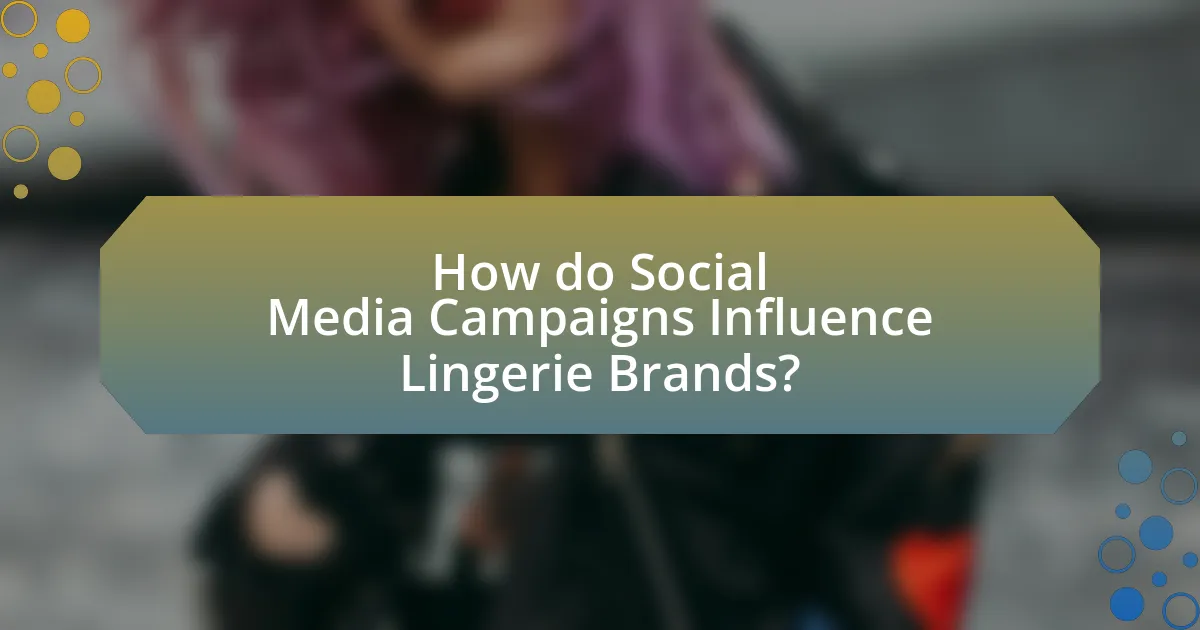
How do Social Media Campaigns Influence Lingerie Brands?
Social media campaigns significantly influence lingerie brands by shaping consumer perceptions and driving purchasing decisions. These campaigns leverage platforms like Instagram and TikTok, where visual content and influencer partnerships create aspirational lifestyles that resonate with target audiences. For instance, a study by the American Marketing Association found that 75% of consumers are influenced by social media when making purchasing decisions, highlighting the effectiveness of these campaigns in the lingerie sector. Additionally, brands that engage in interactive content, such as polls and user-generated content, foster community and loyalty, further enhancing their market presence.
What strategies do lingerie brands use on social media?
Lingerie brands utilize several strategies on social media to enhance their visibility and engagement. These strategies include influencer partnerships, where brands collaborate with social media influencers to reach targeted audiences, leveraging the influencers’ established trust and follower base. Additionally, lingerie brands often create visually appealing content that showcases their products in lifestyle settings, which resonates with consumers and encourages sharing.
Moreover, brands engage in user-generated content campaigns, encouraging customers to share their own photos wearing the products, thus fostering community and authenticity. They also employ targeted advertising to reach specific demographics, utilizing data analytics to refine their marketing efforts. According to a study by the Digital Marketing Institute, 70% of consumers are more likely to purchase from brands they follow on social media, highlighting the effectiveness of these strategies in driving sales and brand loyalty.
How do brands engage with their audience through social media?
Brands engage with their audience through social media by creating interactive content, fostering community, and utilizing targeted advertising. Interactive content, such as polls, quizzes, and live videos, encourages audience participation and enhances engagement. For instance, brands like Victoria’s Secret often host live Q&A sessions on platforms like Instagram, allowing direct interaction with followers. Additionally, fostering a sense of community through user-generated content and brand hashtags enables customers to share their experiences, which strengthens brand loyalty. Targeted advertising on platforms like Facebook and Instagram allows brands to reach specific demographics, ensuring that their messaging resonates with the intended audience. According to a 2021 report by Sprout Social, 64% of consumers want brands to connect with them on social media, highlighting the importance of these engagement strategies.
What types of content are most effective for lingerie marketing?
Visual content, particularly high-quality images and videos, is most effective for lingerie marketing. This type of content captures attention and showcases the product’s details, fit, and style, which are crucial in the lingerie industry. According to a study by HubSpot, visual content is 40 times more likely to be shared on social media than other types of content, highlighting its effectiveness in reaching a broader audience. Additionally, user-generated content, such as customer reviews and photos, enhances authenticity and trust, further driving engagement and sales.
How do social media campaigns impact sales and brand loyalty?
Social media campaigns significantly enhance sales and brand loyalty by increasing brand visibility and fostering customer engagement. Research indicates that brands utilizing social media effectively can see a sales increase of up to 30%, as these platforms allow for direct interaction with consumers, creating a sense of community and trust. For instance, a study by Hootsuite found that 73% of marketers believe that their efforts through social media marketing have been “somewhat effective” or “very effective” for their business. Additionally, social media campaigns often leverage influencer partnerships, which can lead to a 10 times higher return on investment compared to traditional advertising methods, further solidifying brand loyalty among consumers who identify with these influencers.
What metrics indicate the success of social media campaigns in lingerie?
Key metrics indicating the success of social media campaigns in lingerie include engagement rate, conversion rate, reach, and return on investment (ROI). Engagement rate measures interactions such as likes, comments, and shares relative to total followers, reflecting audience interest and connection. Conversion rate tracks the percentage of users who take a desired action, such as making a purchase after engaging with a campaign, indicating effectiveness in driving sales. Reach quantifies the total number of unique users who see the content, showcasing brand visibility. ROI assesses the financial return generated from the campaign relative to its cost, providing a clear picture of profitability. These metrics collectively offer a comprehensive view of a campaign’s performance in the lingerie sector.
How do consumer interactions on social media affect brand loyalty?
Consumer interactions on social media significantly enhance brand loyalty by fostering a sense of community and engagement. When consumers actively participate in discussions, share experiences, and provide feedback on platforms like Instagram or Facebook, they create a personal connection with the brand. This connection is supported by research indicating that 71% of consumers who have a positive social media experience with a brand are likely to recommend it to others, thereby increasing brand loyalty. Additionally, brands that respond to consumer interactions demonstrate attentiveness and care, which further solidifies customer trust and loyalty.
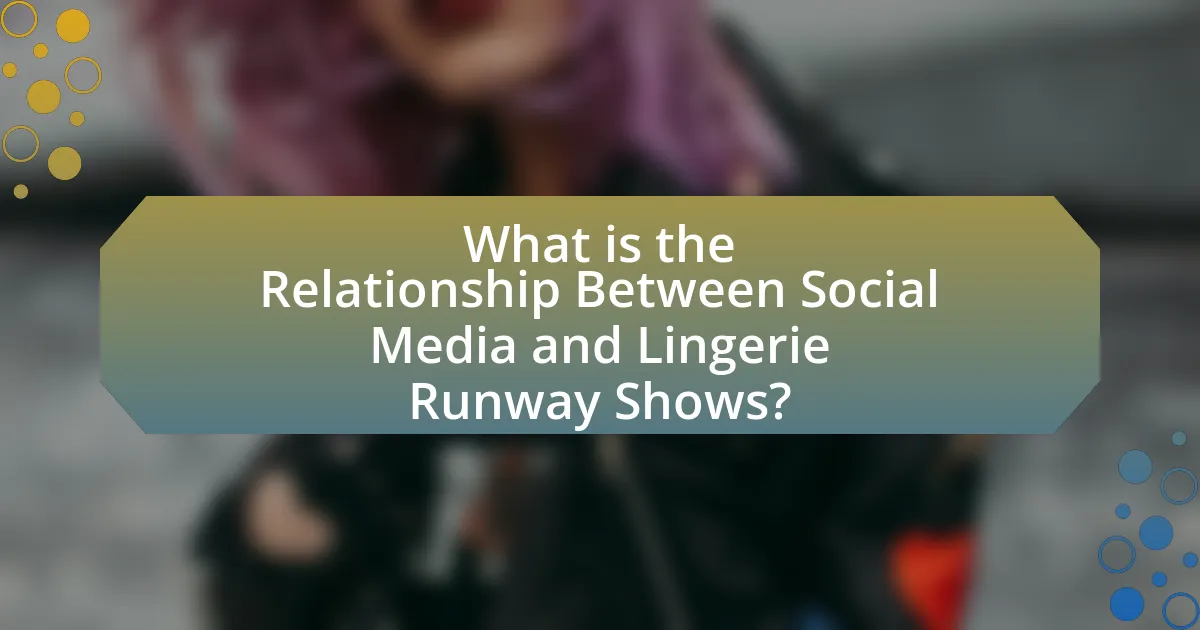
What is the Relationship Between Social Media and Lingerie Runway Shows?
The relationship between social media and lingerie runway shows is significant, as social media platforms serve as vital channels for promoting and disseminating the visibility of these events. Lingerie brands leverage social media to showcase their runway shows, reaching a global audience instantly, which enhances brand awareness and consumer engagement. For instance, the Victoria’s Secret Fashion Show, historically broadcasted on television, saw a shift towards social media promotion, with millions of views on platforms like Instagram and YouTube, demonstrating the effectiveness of social media in amplifying the reach of lingerie runway shows. This integration allows brands to connect with consumers directly, fostering a community around lingerie trends and influencing purchasing decisions.
How has social media changed the way lingerie runway shows are perceived?
Social media has transformed the perception of lingerie runway shows by democratizing access and amplifying visibility. Previously, these events were exclusive, primarily viewed by a select audience, but platforms like Instagram and TikTok now allow millions to engage with the content in real-time. This shift has led to a more diverse representation of body types and styles, as brands are increasingly influenced by user-generated content and feedback. For instance, the Victoria’s Secret Fashion Show faced criticism for its lack of inclusivity, prompting a reevaluation of how lingerie is showcased. Consequently, social media has not only broadened the audience but also reshaped industry standards, making lingerie fashion more relatable and accessible to the general public.
What role does live streaming play in lingerie fashion shows?
Live streaming plays a crucial role in lingerie fashion shows by expanding audience reach and enhancing viewer engagement. It allows brands to showcase their collections in real-time to a global audience, breaking geographical barriers that traditional shows face. For instance, the 2021 Victoria’s Secret Fashion Show utilized live streaming to attract millions of viewers online, significantly increasing brand visibility and interaction. This method not only democratizes access to high-fashion events but also enables immediate feedback and interaction through social media platforms, fostering a sense of community among viewers.
How do social media reactions shape future lingerie collections?
Social media reactions significantly influence future lingerie collections by providing immediate feedback on consumer preferences and trends. Brands analyze likes, shares, and comments to identify popular styles, colors, and materials, allowing them to tailor their offerings to meet consumer demand. For instance, a study by the Fashion Institute of Technology found that 70% of fashion brands use social media analytics to inform their design processes, demonstrating the direct correlation between online engagement and product development. This data-driven approach enables lingerie brands to stay relevant and competitive in a rapidly changing market.
What are the implications of social media for future lingerie trends?
Social media significantly influences future lingerie trends by shaping consumer preferences and driving brand visibility. Platforms like Instagram and TikTok allow brands to showcase diverse styles and body types, promoting inclusivity and body positivity. This shift is evidenced by the rise of brands that prioritize representation, such as Savage X Fenty, which gained popularity through social media campaigns featuring models of various sizes and ethnicities. Additionally, user-generated content and influencer partnerships create authentic connections with consumers, leading to increased engagement and sales. As a result, lingerie brands are likely to continue adapting their offerings to align with the evolving expectations of consumers influenced by social media.
How might emerging platforms influence lingerie trends in the future?
Emerging platforms will significantly influence lingerie trends in the future by enabling direct consumer engagement and fostering niche communities. Social media platforms like Instagram and TikTok allow brands to showcase their products through influencers, leading to real-time feedback and trend adaptation. For instance, a study by McKinsey & Company highlights that 70% of consumers are influenced by social media when making purchasing decisions, indicating the power of these platforms in shaping consumer preferences. Additionally, user-generated content on these platforms encourages diversity in body representation, which can lead to a broader acceptance of various lingerie styles and sizes. This shift towards inclusivity is already evident, as brands increasingly feature diverse models and styles that resonate with a wider audience.
What can brands learn from social media analytics to predict trends?
Brands can learn consumer preferences and emerging trends from social media analytics by analyzing engagement metrics, sentiment analysis, and trending topics. Engagement metrics, such as likes, shares, and comments, provide insights into what styles or products resonate with audiences, while sentiment analysis reveals consumer feelings towards specific brands or products. For instance, a study by Sprout Social found that 70% of consumers feel more connected to brands that engage with them on social media, indicating that brands can leverage this connection to identify and predict trends. Additionally, monitoring trending hashtags and discussions can help brands stay ahead of shifts in consumer interests, allowing them to adapt their offerings accordingly.
What best practices should lingerie brands follow on social media?
Lingerie brands should prioritize authenticity, engagement, and visual storytelling on social media. Authenticity builds trust; brands like Aerie have successfully used unretouched images to resonate with their audience, resulting in a 20% increase in sales. Engagement is crucial; responding to comments and messages fosters community, as seen with brands like Savage X Fenty, which actively interacts with followers. Visual storytelling is essential; high-quality images and videos showcasing products in relatable contexts can enhance brand appeal, evidenced by Victoria’s Secret’s use of lifestyle imagery that connects with consumers. These practices collectively enhance brand loyalty and drive sales in the competitive lingerie market.
How can brands effectively collaborate with influencers in the lingerie space?
Brands can effectively collaborate with influencers in the lingerie space by selecting influencers whose audience aligns with their target market and values. This alignment ensures that the influencer’s followers are likely to be interested in the brand’s products, increasing engagement and conversion rates. For instance, a study by the Digital Marketing Institute found that 49% of consumers depend on influencer recommendations, highlighting the importance of choosing the right influencer. Additionally, brands should provide influencers with creative freedom to showcase products authentically, as authenticity resonates more with audiences. Collaborations can also include exclusive discount codes or giveaways, which incentivize followers to make purchases. By leveraging these strategies, brands can enhance their visibility and credibility in the lingerie market.
What strategies can enhance consumer engagement on social media for lingerie brands?
To enhance consumer engagement on social media for lingerie brands, implementing interactive content such as polls, quizzes, and live Q&A sessions is essential. These strategies encourage direct participation from consumers, fostering a sense of community and connection with the brand. For instance, brands that utilize Instagram Stories to conduct polls about product preferences see increased interaction rates, with reports indicating that such features can boost engagement by up to 30%. Additionally, collaborating with influencers who resonate with the target audience can amplify reach and authenticity, as studies show that 49% of consumers depend on influencer recommendations for their purchasing decisions. Engaging storytelling through user-generated content also enhances relatability, as brands that showcase real customers wearing their products often experience higher engagement levels, with a 28% increase in likes and shares.













